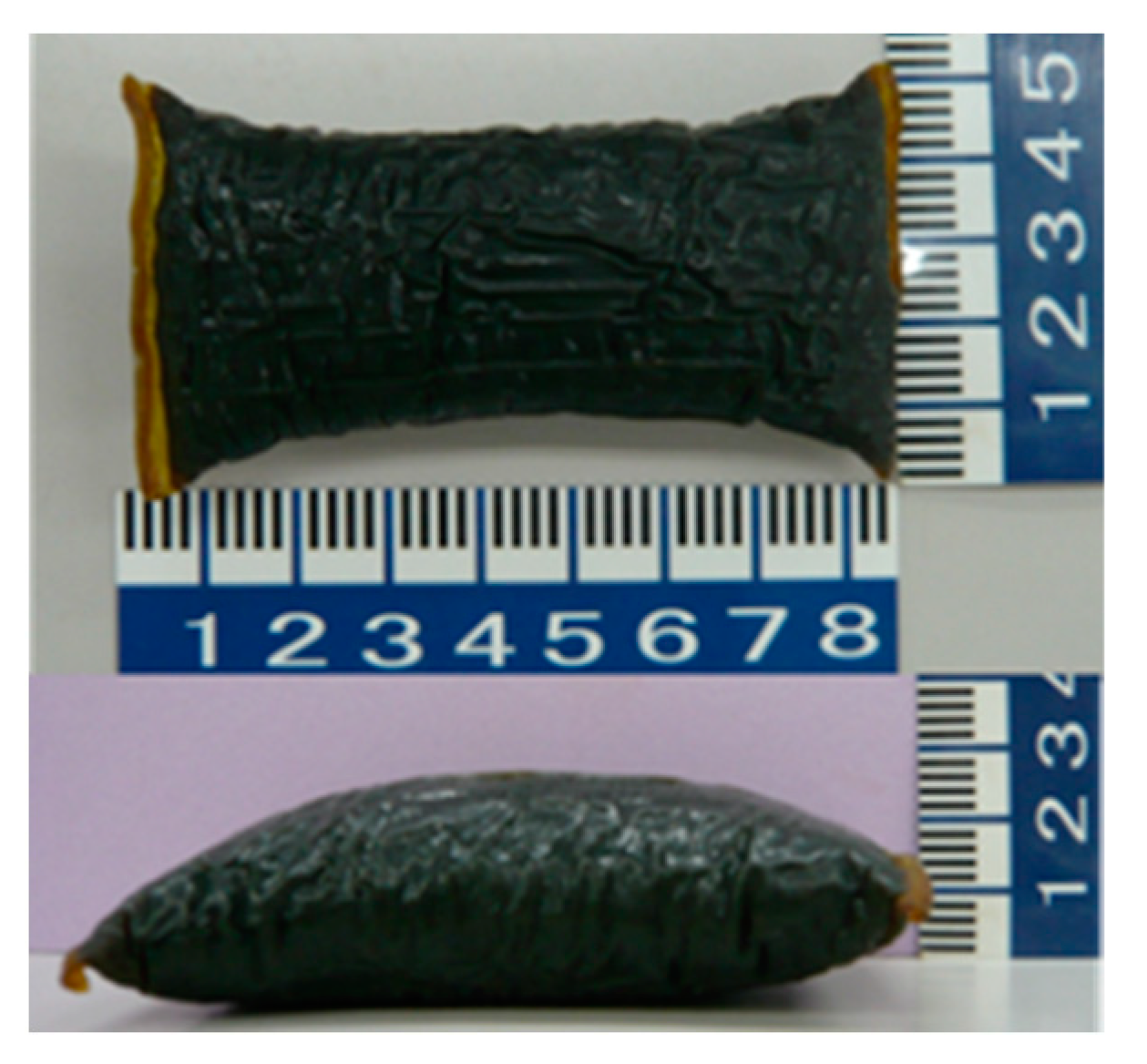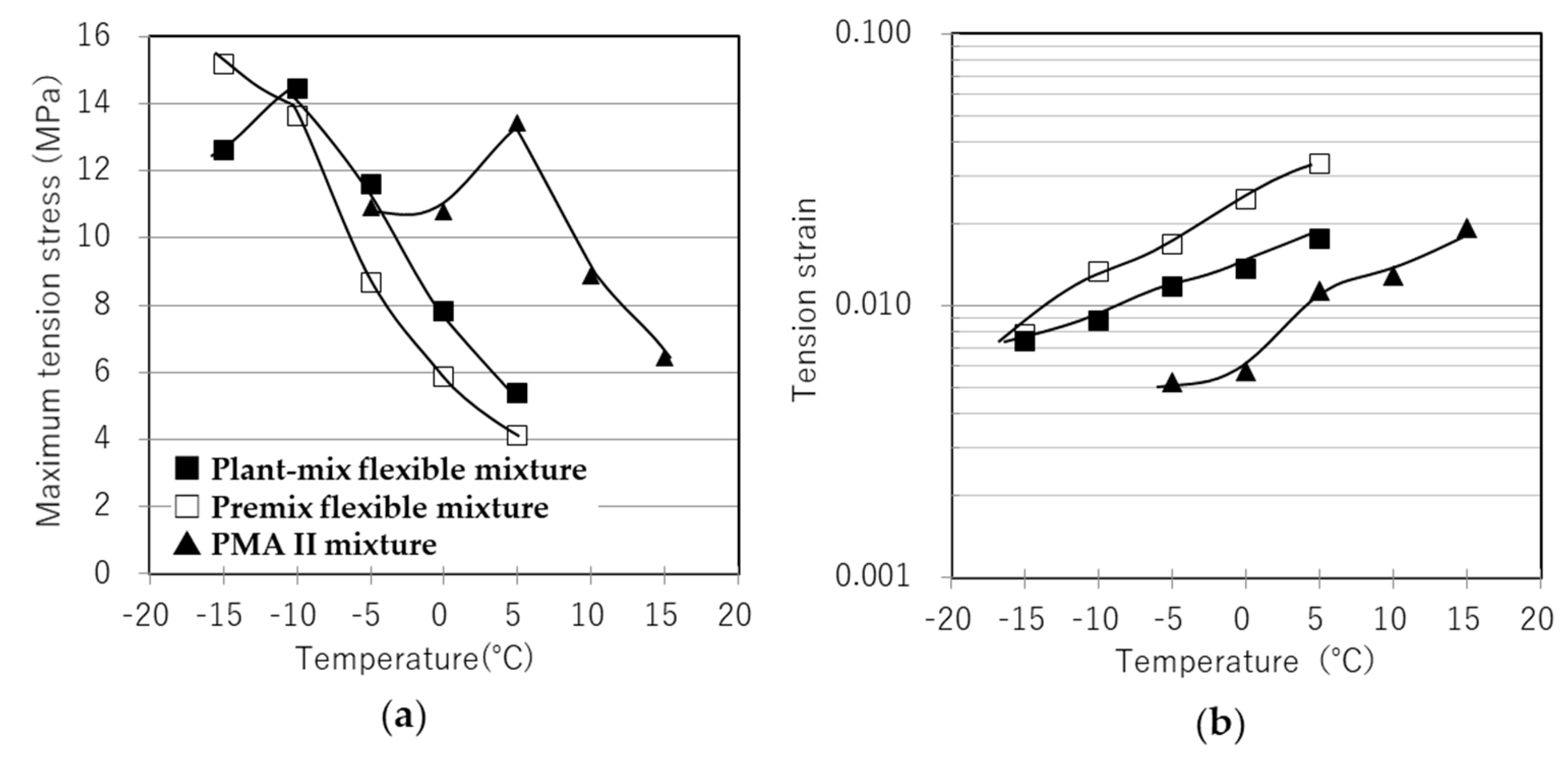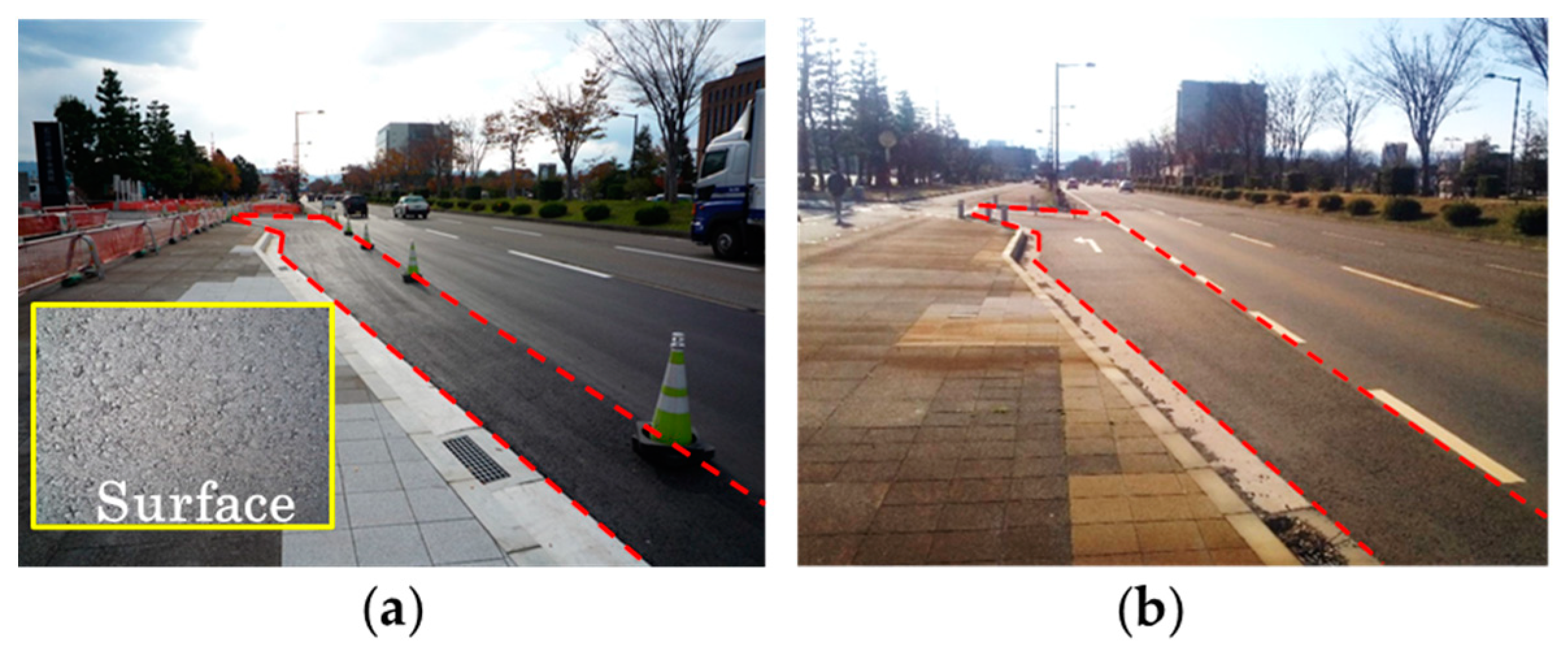Development of Plant-Mix-Type Modified Mixture with Excellent Flexibility and Stress Relaxation Properties for Ensuring High Resistance to Cracking †
Abstract
:1. Introduction
2. Concept Development of the Special Asphalt Binder
3. Experimental Work, Results and Discussion
3.1. Characterization Tests of Asphalt Binder
3.2. Characterization Tests of Asphalt Mixture
4. Plant Results and Discussion
5. Field Test Section for Validation of the Plant-Mix Flexible Mixture
6. Conclusions
- The present study developed a premix flexible mixture and a plant-mix flexible mixture that have both high cracking resistance and high rutting resistance.
- Using the plant-mix flexible asphalt mixture is an effective solution for manufacturing a highly flexible asphalt mixture in small quantities that is able to respond to small-scale and emergency constructions.
Author Contributions
Funding
Institutional Review Board Statement
Informed Consent Statement
Data Availability Statement
Conflicts of Interest
References
- Japanese Ministry of Land, Infrastructure, Transport and Tourism. Pavement Inspection Guidelines; MILT: Tokyo, Japan, 2016. [Google Scholar]
- Takahashi, S.; Ono, Y.; Sato, M. Project for detailed instructions on asphalt pavement. Pavement 2016, 51, 13–19. [Google Scholar]
- Konno, M.; Otomo, N.; Isayama, H.; Kokufuda, Y. Development of asphalt binder with high rutting resistance and high cracking resistance. Road Constr. 2017, 765, 63–69. [Google Scholar]
- Japan Road Association. Pavement Construction Handbook; Japan Road Association: Tokyo, Japan, 2006. [Google Scholar]
- Japan Road Association. Pavement Handbook and Test Method Handbook; Japan Road Association: Tokyo, Japan, 2019; Volume 3. [Google Scholar]
- Tran, N.T.; Takahashi, O. A comparative analysis of the fracture performance of wearing course mixtures under different geometries, compactions, and aggregate gradations. Int. J. Pavement Eng. 2020, 21, 1703–1715. [Google Scholar] [CrossRef]
- Tran, N.T.; Takahashi, O. A comprehensive evaluation of the effects of aggregate gradation on the shear strength properties of wearing course mixtures. Int. J. Pavement Eng. 2021, 22, 550–559. [Google Scholar] [CrossRef]
- Karaki, K.; Kizawa, S.; Okajima, H. Long-term performance of specially modified asphalt mixture with excellent cracking resistance. In Proceedings of the 34th Japan Road Conference, Tokyo, Japan, 4–5 November 2021. Paper 3018. [Google Scholar]




| Properties | Plant-Mix Binder | Premix Binder | PMA II | |
|---|---|---|---|---|
| Penetration | 1/10 mm | 146 | 135 | 54 |
| Penetration index PI | 8.9 | 9.3 | 1.6 | |
| Viscosity at 60 °C | Pa·s | 7320 | 9670 | 2574 |
| Fragility point | °C | −30 | −34 | −14 |
| Fracture energy (−20 °C) | ×10−3 MPa | 1583 | 1028 | 157 |
| Fracture toughness (−20 °C) | MPa | 40 | 32 | 270 |
| Dynamic shear |G*|sinδ (25 °C) * | 105 Pa | 0.9 | 0.6 | 9.5 |
| Sieve size (mm) | 19.0 | 13.2 | 4.75 | 2.36 | 0.600 | 0.300 | 0.075 |
| Criteria (%) | 100 | 95~100 | 52~72 | 40~60 | 25~45 | 16~33 | 8~13 |
| Percent passing (%) | 100 | 99.8 | 71.3 | 54.3 | 33.3 | 20.6 | 8.0 |
| Evaluation | Test | Standard |
|---|---|---|
| Cracking resistance | TPBB test (−15 °C~15 °C, 6.25 × 10−3 1/s strain rate) | JRA-B005 |
| Fatigue resistance | FPBF test (5 °C, 5 Hz, 400 μm) | JRA-B018T |
| Rutting resistance | WTT (60 °C, 686 N, 42 cycles/min) | JRA-B003 |
Disclaimer/Publisher’s Note: The statements, opinions and data contained in all publications are solely those of the individual author(s) and contributor(s) and not of MDPI and/or the editor(s). MDPI and/or the editor(s) disclaim responsibility for any injury to people or property resulting from any ideas, methods, instructions or products referred to in the content. |
© 2023 by the authors. Licensee MDPI, Basel, Switzerland. This article is an open access article distributed under the terms and conditions of the Creative Commons Attribution (CC BY) license (https://creativecommons.org/licenses/by/4.0/).
Share and Cite
Tran, N.T.; Aoki, M. Development of Plant-Mix-Type Modified Mixture with Excellent Flexibility and Stress Relaxation Properties for Ensuring High Resistance to Cracking. Eng. Proc. 2023, 36, 20. https://doi.org/10.3390/engproc2023036020
Tran NT, Aoki M. Development of Plant-Mix-Type Modified Mixture with Excellent Flexibility and Stress Relaxation Properties for Ensuring High Resistance to Cracking. Engineering Proceedings. 2023; 36(1):20. https://doi.org/10.3390/engproc2023036020
Chicago/Turabian StyleTran, Nhat Thanh, and Masashige Aoki. 2023. "Development of Plant-Mix-Type Modified Mixture with Excellent Flexibility and Stress Relaxation Properties for Ensuring High Resistance to Cracking" Engineering Proceedings 36, no. 1: 20. https://doi.org/10.3390/engproc2023036020
APA StyleTran, N. T., & Aoki, M. (2023). Development of Plant-Mix-Type Modified Mixture with Excellent Flexibility and Stress Relaxation Properties for Ensuring High Resistance to Cracking. Engineering Proceedings, 36(1), 20. https://doi.org/10.3390/engproc2023036020






